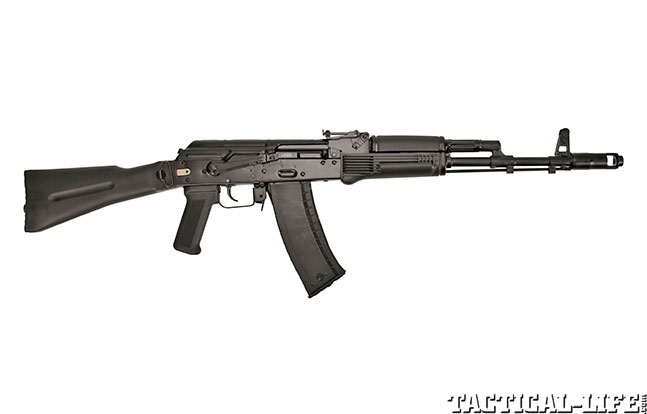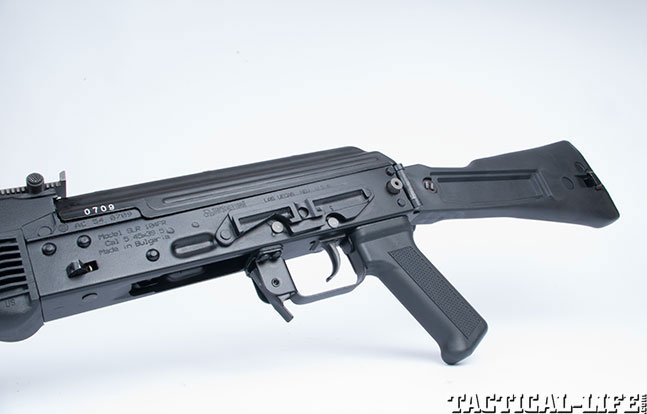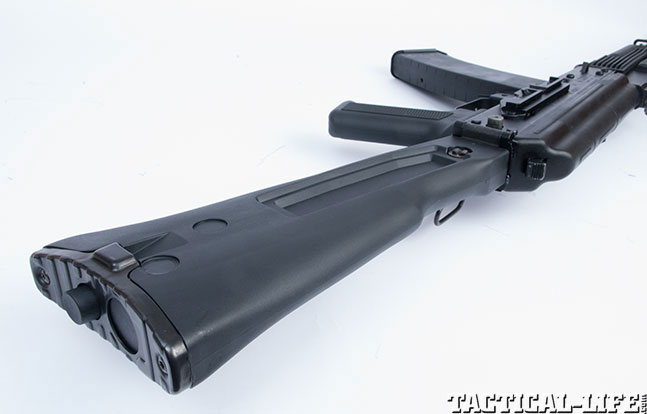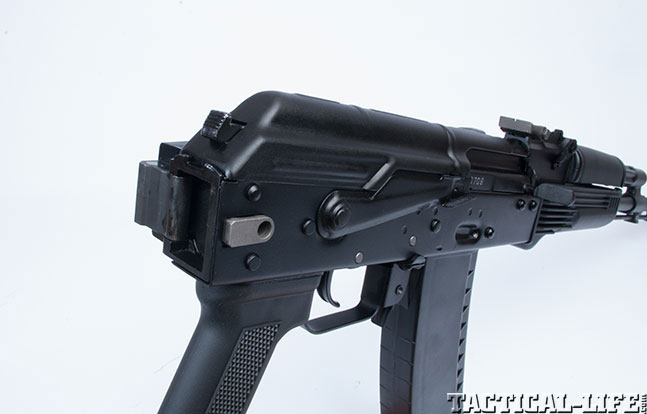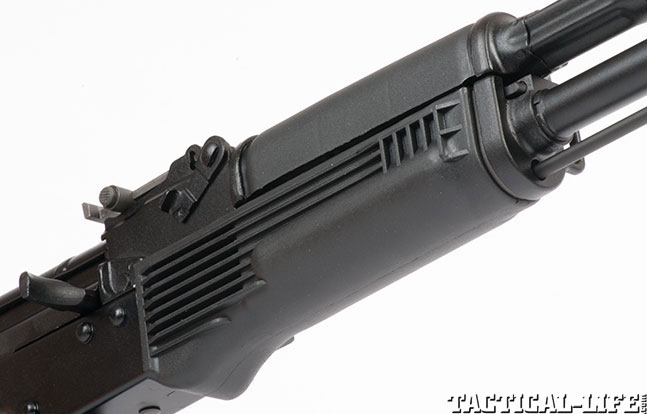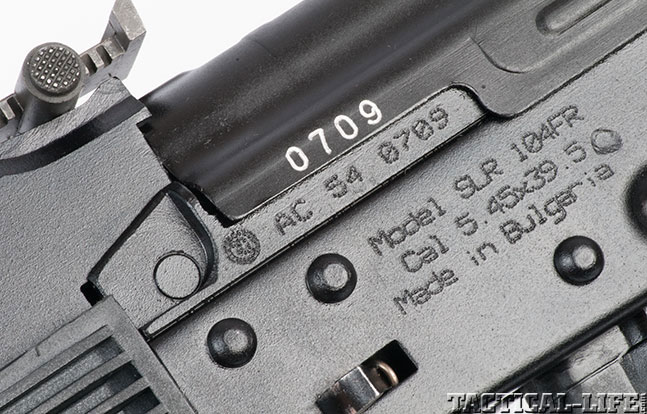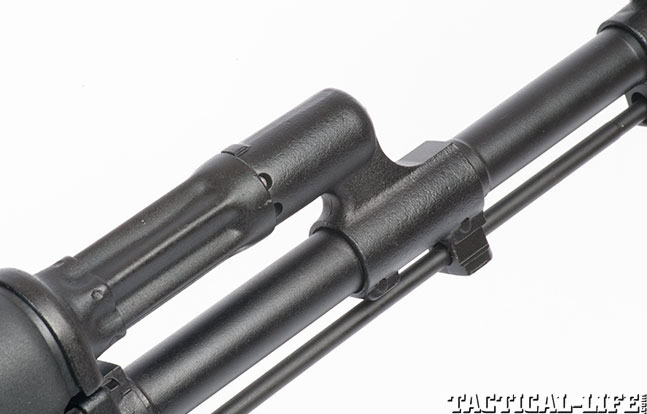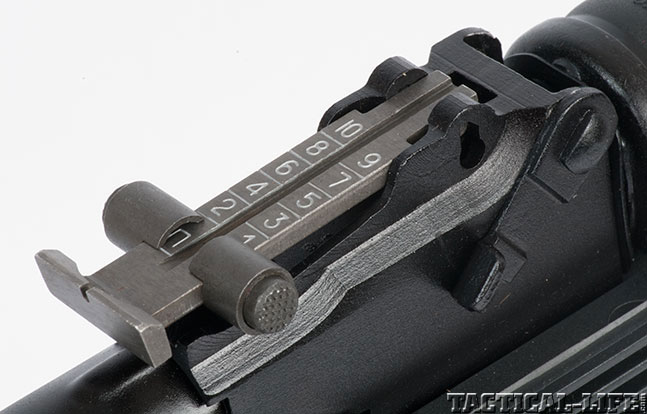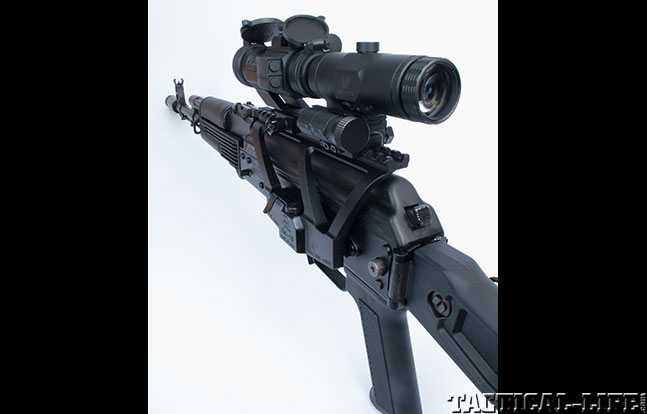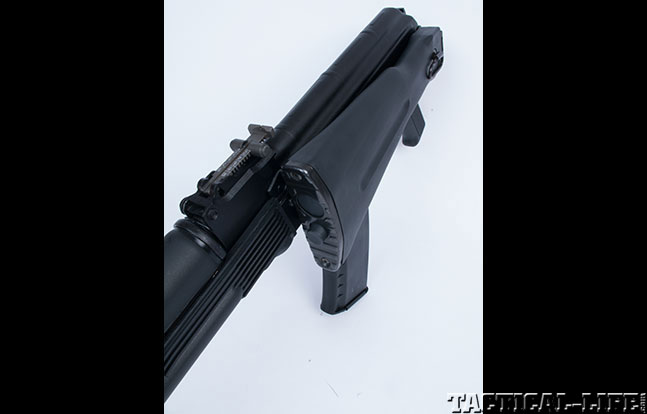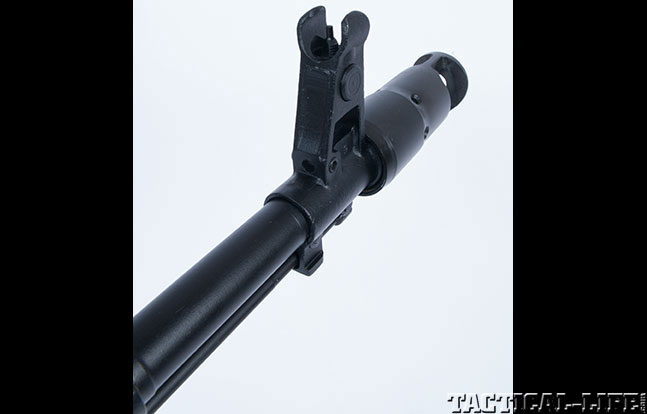While the 7.62x39mm AK may be the most recognizable of the Kalashnikov series of rifles, its often-overlooked younger brother—the 5.45x39mm AK-74—is an outstanding warrior in its own right.
And thanks to the efforts of Arsenal, Inc. here in the United States, we now have a Bulgarian-American variant in its SLR-104FR that gives U.S. shooters a chance to own their own version of the venerable Russian AK-74M version of the design.
- RELATED: East Meets West: Top 10 Hybrid AK-AR Platforms For 2015
- RELATED: Top 14 Rails, Mounts & Handguards For the AK Platform
For those unfamiliar with the history of the AK-74 series of rifles, its birth coincides with that of another modern military warrior—the U.S. M16. When the M16 appeared in the 1960s, it sent shockwaves through the world’s military small arms community. Preceding the birth of this design, most small arms were made of wood and steel, and were designed to lob a reasonably heavy projectile at a reasonably fast speed.
Advertisement — Continue Reading Below
However, with the appearance of the M16 designed to fire the 5.56x45mm cartridge, a new era of firearms design was born. Now firearms could employ ultra-modern materials and manufacturing techniques (namely plastics and aluminum), and would also fire cartridges that approached downrange lethality from a totally different perspective. The low-impulse 5.56mm cartridge offered a light-recoiling round propelled at an extremely high velocity, offering greater ammunition load capacity due to its lighter weight as well as enhanced control during fully automatic fire.
At the same time the as M16 made its debut on the battlefields of Vietnam, the Soviets were already in the midst of their own efforts to modernize the AK-pattern rifle. The AK had been enhanced and updated in the late 1950s in the Avtomat Kalashnikova Modernizirovanniy (AKM), which perfected a stamped steel receiver for the design and introduced a laminated stock set. The result was a lighter, stronger and lower-cost version of the AK.
Despite the advantages provided by the AKM, the Soviet defense industry still saw a need for a next generation of weapon—and the appearance of the M16 accelerated its efforts. After examining captured examples of the M16 and its new cartridge, the Soviets determined that developing a new, equally revolutionary small arm to directly compete with the M16 was unfeasible. However, they did decide that updating the proven AKM was a viable alternative. So, a program to develop the next generation of the AK was set into motion.
Advertisement — Continue Reading Below
It’s All Relative
A close examination of the AKM in this new light determined that a modernized chambering would be the most logical next step. While the 7.62x39mm M43 cartridge had been an undeniable success, it was showing its age since its birth in the 1940s. However, the Soviets needed to develop a new cartridge that would easily work in an AKM-style design without requiring too much redesigning.
Advertisement — Continue Reading Below
“The new AK-74M … took everything the Soviet’s had learned about producing the AK-74 and combined it into a single new platform.”
The result was the 5.45x39mm cartridge, which shared a similar overall length to that of the 7.62x39mm and followed the same “intermediate” cartridge design concept of its older sibling. As a result, it would be much easier to adapt the 5.45mm to the AKM platform. The new cartridge propelled a 50- to 60-grain projectile at around 3,100 feet per second, placing it in the same neighborhood of performance as the West’s 5.56x45mm.
This left Soviet engineers facing the development of a new rifle for the new cartridge. Not looking to unnecessarily redesign the wheel (and frankly incapable at that time of matching the West’s mastery of modern materials and manufacturing), the new AK-74 was a logical and relatively conservative adaptation of the AKM. The earliest models from the mid-1970s retained the laminated wood stock system and similar overall dimensions and weight of the AKM. What was changed externally was the addition of a new large, cylindrical muzzle brake, a horizontal groove along the buttstock and composite-bodied magazines. Also, the gas block of the AKM was eventually modified from its original 45-degree angle to that of a sharper 90-degree angle to reduce bullet shearing.
Advertisement — Continue Reading Below
The AK-74 proved to be a solid update of the proven AKM, with it delivering exactly what the Soviet engineers intended—a small-caliber weapon that did not alter the positive characteristics of the parent design. Basically, it built on the strengths of the AKM while adding the new capabilities the Soviet military desired. The AK-74 went on to serve in Afghanistan, and siblings of the design began to pop up in the satellite states of Eastern Europe.
The Next, Next Generation
Advertisement — Continue Reading Below
A notable next step in the evolution came during the tumultuous year of 1991, when the Soviet empire finally collapsed. From its introduction in the mid-1970s through to this era, the AK-74 had been developed into numerous variants and upgrades. AKS-74 rifles with skeletonized steel stocks were developed for more compact dimensions. Also, as the Soviet’s mastery of modern materials improved, the AK-74 was updated with enhancements such as synthetic stock sets that offered lighter weights than earlier laminated stock sets.
“When it comes to Kalashnikov-pattern rifles, many consider Arsenal’s guns to be the ‘Cadillacs’ of the market.”
The new AK-74M (with the “M” standing for “modernized”) took everything the Soviet’s had learned about producing the AK-74 and combined it into a single new platform. Externally, it would appear to many to be simply an AK-74 with a synthetic stock set (with the recognizable horizontal groove in the buttstock), but closer examination would reveal much more.
Advertisement — Continue Reading Below
With the AK-74M, a full-profile synthetic buttstock was designed that would fold along the left side of the receiver. When extended, the stock looked like any standard full-profile buttstock. The result was a rifle that featured the good ergonomics of a full-profile buttstock, but with the compactness of a folding-stock gun when needed.
While the right side of the buttstock featured the familiar 74-style horizontal groove, the left side of stock had a large rectangular recess to allow room for the side-mounted optic rail. A release button for the stock was located at the rear left corner of the receiver. One simply pressed in the button and the stock would fold along the left side of the receiver and be captured by an exposed hook at the forward left end of the receiver. To release the stock, there was a push button in the ribbed buttplate (below the cleaning kit storage door) that would release the stock for opening.
Other changes established with the new AK-74M was a return to a non-ribbed top cover, which set it apart from the AKM-style top cover of earlier guns, and a redesigned, two-piece muzzle brake. The AK-74M was notable in that it eliminated the need of having both fixed and folding-stock models, and it served as the basis for what would become the AK-100 series in the post-Soviet era.
Advertisement — Continue Reading Below
Appealing Alternative
Obviously, acquiring a semi-automatic version of the Russian AK-74M would be very difficult for a U.S. consumer due to importation regulations and restrictions. However, there is another option, and it is the result of a fortuitous relationship between the famed Arsenal in Bulgaria and Arsenal, Inc., its exclusive representative here in the United States. Arsenal, Inc. is a fully licensed affiliate of the Bulgarian manufacturer that manufactures (and remanufactures) AKs here in the U.S.
Advertisement — Continue Reading Below
When it comes to Kalashnikov-pattern rifles, many consider Arsenal’s guns to be the “Cadillacs” of the market. Basically, the Bulgarian guns are considered to be just about the closest you can get in both quality and design to original Russian guns. It is important to note that the company is not simply an importer of Arsenal’s products, but rather a fully functional manufacturing facility in its own right with independent production and R&D teams.
Full disclosure here—I am a bit of an AK-74 fanatic. As a result, I had been hounding Arsenal, Inc. for the past few years for a Bulgarian-based, AK-74M-style rifle. Needless to say, I was pretty ecstatic when I saw the press release for the SLR-104FR. In a recent conversation with Arsenal, Inc.’s Harry Pakhanyan, he explained to me that the 104 was developed to complete the SLR line.
“We wanted to add a member to the SLR line in the 5.45x39mm round. We had picked up on a strong demand for a factory-original, high-quality rifle in this cartridge here in the United States,” he explained.
The SLR designation stands for “self-loading rifle,” and “104” is the family designation for the 5.45x39mm series of rifles. The “FR” indicates that it features a folding stock as well as a side-mounted optic rail. “The SLR-104FR is our flagship model in the 5.45x39mm series,” Harry explained.
While researching the article, I visited the Bulgarian Arsenal’s website to see if there was a corresponding model to the SLR-104FR in its current line but could not find one. When I asked Pakhanyan about this, he explained that the SLR-104FR is designed exclusively for the U.S. market. “The 5.45x39mm stamped-receiver gun is not a standard production model in Bulgaria anymore. The factory may manufacture this chambering under special requirements, which is exactly what happened with the case of the SLR-104FR,” he stated. “The SLR-104 series rifles were specifically designed and manufactured for the U.S. market, in close collaboration with Arsenal, Inc.”
My next inquiry for Pakhanyan regarded how the rifle is manufactured, and what is the breakdown of domestic versus Bulgarian parts. He explained to me that one of the things that sets Arsenal, Inc.’s guns apart from others on the U.S. market is that they are fully factory manufactured rifles. “The Bulgarian components include the cold-hammer-forged, chrome-lined barrel and the mil-spec stamped steel receiver, to name just a few,” Pakhanyan explained.
He made a point that these rifles are not reverse-engineered here in the U.S., but built correctly from the start. The U.S.-made components of the rifle are a polymer stock set, the fire control group and the muzzle brake—all produced stateside under the same specs and quality control as comparable Bulgarian parts. Arsenal, Inc. even adds its own upgrades such as stainless steel heat shields in the handguards and two-stage fire control groups.
Range Report
I recently had an opportunity to try out one of the SLR-104FR rifles for myself. Having tested several Arsenal, Inc. firearms in the past, I expected a quality product and was not disappointed. The rifle came packed in a cardboard box with a 30-round polymer magazine, a sling, oiler and cleaning kit. Arsenal, Inc. was kind enough to include an SM-13 scope mount as well as several additional 30-round magazines for testing.
The fit and finish of the rifle was top notch, and all controls worked smoothly. I did note some tightness in the stock release button, but discovered that bending the stock outward a bit relieved the tension on it and made it easier to disengage to fold the stock. Close inspection of the rifle revealed the classic “Circle 10” logo on the trunnion and the magazines. Visually, the rifle is a dead ringer for a semi-automatic AK-74M, apart from a few relatively minor differences such as the rifle’s AKM-style ribbed top cover and the fact the rifle features a one-piece muzzle brake more like the original Russian AK-74 design.
For testing, I fitted the SLR-104FR out with the SM-13 scope mount on the side-mounted optics rail and topped it off with a Vortex StrikeFire II reflex sight paired with a VMX-3T 3X magnifier unit on a flip-to-side mount. I inspected and lubed the rifle and headed out to the range with some Hornady 60-grain V-Max steel-cased ammunition. Set up on the bench, I shot the rifle for groups at 100 yards and got a tightest group of 3.25 inches, with it averaging around 4 inches for all groups. I then moved on to some drills with double- and triple-taps, running a couple hundred rounds through the rifle. During the entire test it ran without a hiccup.
As a fan of the AK-74 series of rifles, I was thrilled by the chance to try out a 5.45mm like this Arsenal SLR-104FR. I have long wanted a side-folding rifle that is a close representation of the Russian AK-74M, and thanks to Arsenal, Inc. I now have a chance to own one. If your tastes are similar to mine, you should take a look for yourself.
For more information, visit arsenalinc.com or call 702-643-2220.
